#cleveland-lloyd quarry
Explore tagged Tumblr posts
Text
Fossil Friday

Allosaurus fragilis teaching her offspring how to hunt Barosaurus lentus at NHMU.
#paleontology#fossils#dinosaur#utah#natural history#museum#late jurassic#Cleveland-Lloyd quarry#jurassic national monument
110 notes
·
View notes
Text
homunculus facts¡
previous analysis of paleohomunculi found in the morrison formation rocks of utah theorized that they died by drowning in a muddy slime they mistook for the potion•
new scans of the mudstone matrix indicates that the environment was rich in microscopic gnomes' which homunculi of the day preyed on relentlessly•
the mud may in fact have acted as a predator trap' which is more consistent with modern homunculus behavior•
also' one specimen was found with a coat of flannel·like filaments' indicating that the modern tumblr strategy of craft material homunculi is older than we previously supposed•
i would not chase a gnome into mud• i would eat it long before it got that far• (✷෴✷)
#homunculus#homunculus facts#wizardposting#unreality#i will kill and eat every gnome#i hate gnomes so much#fuck the gnomes#i hate gnomes#alchemy#paleoalchemy#morrison formation#jurassic#cleveland lloyd dinosaur quarry#craft supplies
36 notes
·
View notes
Photo
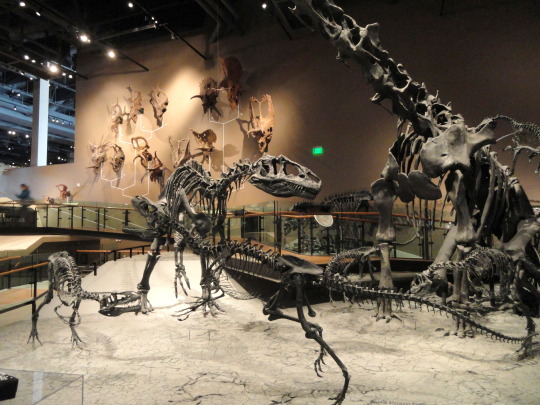
A photo of the Past Worlds exhibit at the Natural History Museum of Utah, which includes representations of various dinosaurs found in the Cleveland-Lloyd Dinosaur Quarry.
#Palaeoblr#Dinoblr#Natural History Museum of Utah#NHMU#Jurassic#Mesozoic#Extinct#Prehistoric#Museum#Photo#Dinosaurs#Ceratopsian#Theropod#Sauropod
185 notes
·
View notes
Text

Allosaurus fragilis middle toe claw replica. Cast of a fossil found in the Morrison formation at the Cleveland-Lloyd Quarry in central Utah. The real fossil is somewhere between 156 to 130 million years old.
[Image ID: A large, curved claw roughly 4 inches in length. It is gray-brown in color and has a socket where the toe bone would attach. In the opposite side, it curves into a sharp point. End ID]
Please let me know if I’m doing the image description incorrectly and/or what I could add to improve it.
8 notes
·
View notes
Text

This is a replica claw from the large middle toe of an Allosaurus, from the Jurassic, around 156-130 million years ago. According to the paper that came with it when I bought it, the replica is of a specimen from the Morrison formation at the Cleveland-Lloyd Quarry in central Utah. This is the only piece of vulture culture that I purchased online.
Measuring from the tip of the claw to the furthest back part, it is about 5.5 inches (14 centimeters) long.
This claw was not used as a weapon for Allosaurus, but instead, being part of the foot, was for walking, and possibly holding down struggling prey or pinning a carcass in place as the animal ate a meal.
2 notes
·
View notes
Photo

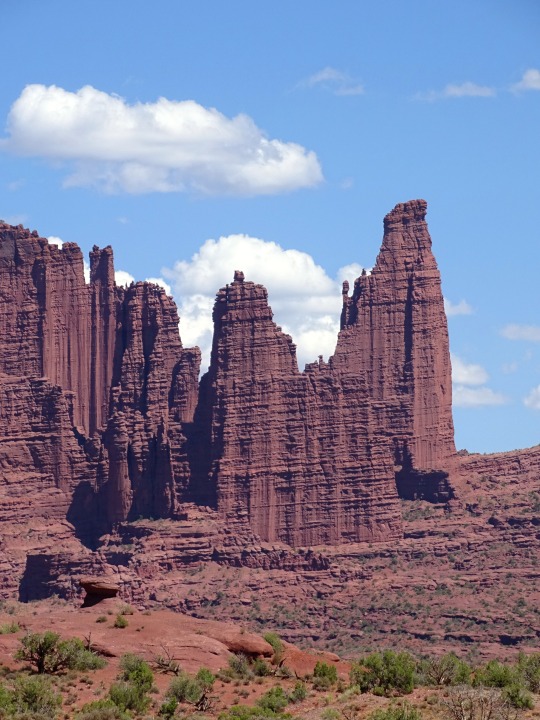

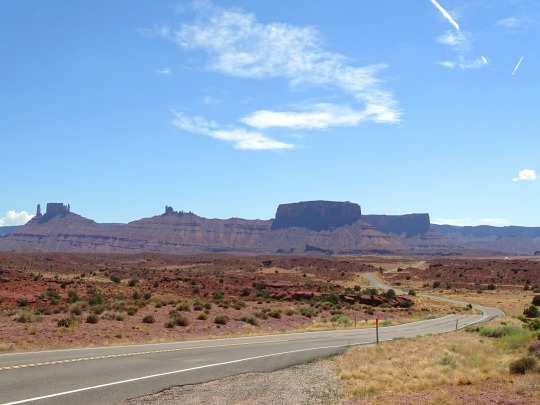
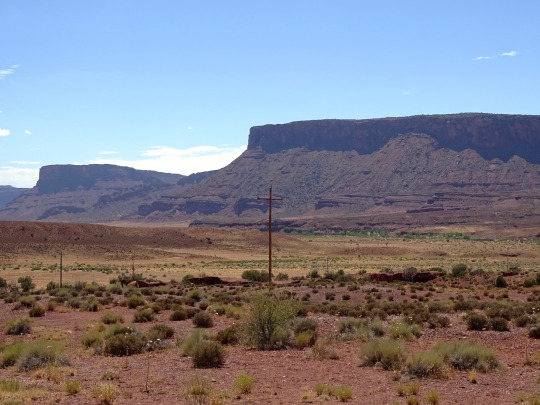



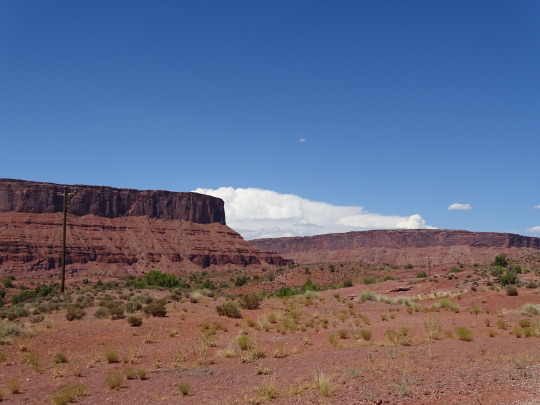

Hwy 128 Colorado River Scenic Byway, UT (No. 12)
Traveling 34 miles (55 km) west of Dinosaur, Colorado, the Dinosaur Diamond encounters the small city of Vernal, Utah. Vernal borders the western end of the Dinosaur National Monument; other notable attractions nearby include Steinaker State Park, Red Fleet State Park, Flaming Gorge National Recreation Area, and the Ashley National Forest.
Continuing along the Dinosaur Diamond, US 40 and US 191 converge within Vernal, heading west for 30 miles (48 km) to the city of Roosevelt. Roosevelt is located on the edge of the Uintah and Ouray Indian Reservation. Heading 29 miles (47 km) to the west is the county seat of Duchesne, located within the reservation. Nearby Duchesne are Starvation State Park and Kings Peak (the highest point in Utah), which is part of the Uinta Mountain range. The Uinta Mountains are one of the few mountain ranges in the contiguous United States which run east–west, and are the highest range to do so.
Within Duchesne, US 40 and US 191 diverge, and the DD continues 55 miles (89 km) south along US 191 over an unnamed mountain pass, through the small town of Helper, and into the larger city of Price. The numerous attractions surrounding Price include College of Eastern Utah Prehistoric Museum, Manti-La Sal National Forest, Huntington Lake State Park, Scofield State Park, and Ninemile Canyon which features numerous petroglyphs. Also nearby is the Cleveland-Lloyd Dinosaur Quarry, a prehistoric mud trap which claims to be the densest concentration of Jurassic dinosaur fossils in the world.
Traveling 63 miles (101 km) southeast along US 191, the DD encounters the city of Green River. Notable features surrounding Green River include the San Rafael Swell, Green River State Park, and Goblin Valley State Park. Also nearby is Crystal Geyser, a rare (but man-made) cold water geyser caused by the expansion of carbonized "soda pop" water within. Within Green River, US 191 converges with I-70 for a short while and diverges again, south towards the city of Moab, 55 miles (89 km) from Green River.
Just south of the junction of US 191 and SR-128, the city of Moab features a number of nearby attractions. Arches National Park, Canyonlands National Park, Dead Horse Point State Park, and the Newspaper Rock and Potash Road petroglyphs.
Leaving Moab, the DD continues north along SR-128 to its terminus with I-70 in Cisco. Traveling east along I-70, before completing the "diamond" back in Grand Junction, Colorado.
Source: Wikipedia
#Dinosaur Diamond Prehistoric Highway#Hwy 128 Colorado River Scenic Byway#Utah 128#Hwy 128 Scenic Byway#Upper Colorado River Scenic Byway#USA#National Scenic Byway#road trip#desert#geology#nature#landscape#countryside#nice drive#cliff#canyon#mesa#original photography#travel#Utah#vacation#summer 2022#SR-128#blue sky#clouds#red rock#rock formation
11 notes
·
View notes
Text

Dinosaur track and bone. Emery County.
#utah#no filter#nofilter#utahphotographer#utah photos#utahisrad#desert#landscape#hiking#public lands#paleontology#dinosaur#fossil track#fossil#Cleveland Lloyd Dinosaur Quarry#Jurassic National Monument#national monument
49 notes
·
View notes
Text
Fossil Friday: Allosaurus
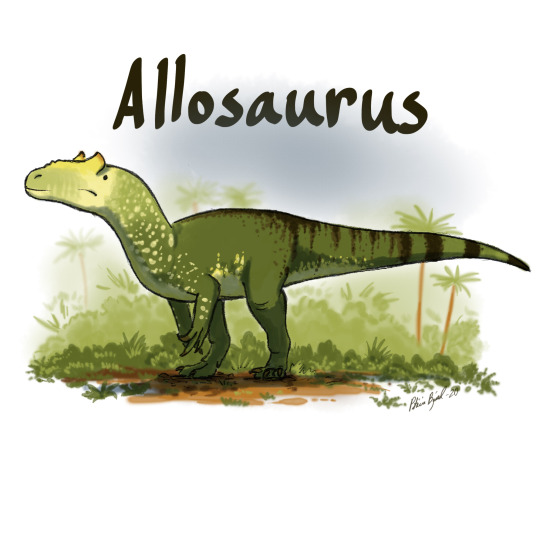

Species: Allosaurus fragilis (ah-loe-sore-us frrah-gee-lees)
What it means: Strange reptile
Other Species: A. europaeus, A. jimmadseni
Where I live: Western U.S.A.- The Morrison Formation / Portugal – The Lourinha Formation
When to find me: The Late Jurassic period, about 155 million years ago.
My favorite food: Meat! I’m a carnivore.

My neighborhood:The Morrison Formation…
View On WordPress
#Allosaurus#Cleveland-Lloyd dinosaur quarry#dinosaur#Dinosaur facts#Dinosaur National Monument#field guide#fossil friday#Morrison formation#research#science
2 notes
·
View notes
Text

Cleveland Lloyd Dinosaur Quarry
2K notes
·
View notes
Photo

Is a genus of large carnosaurian theropod dinosaur that lived 155 to 145 million years ago during the Late Jurassic epoch (Kimmeridgian to late Tithonian). The name "Allosaurus" means "different lizard" alluding to its unique (at the time of its discovery) concave vertebrae. It is derived from the Greek ἄλλος (allos) ("different, other") and σαῦρος (sauros) ("lizard / generic reptile"). The first fossil remains that could definitively be ascribed to this genus were described in 1877 by paleontologist Othniel Charles Marsh. As one of the first well-known theropod dinosaurs, it has long attracted attention outside of paleontological circles. Allosaurus was a large bipedal predator. Its skull was light, robust and equipped with dozens of sharp, serrated teeth. It averaged 10 meters (33 ft) in length, though fragmentary remains suggest it could have reached over 12 m (39 ft). Relative to the large and powerful hindlimbs, its three-fingered forelimbs were small, and the body was balanced by a long and heavily muscled tail. It is classified as an allosaurid, a type of carnosaurian theropod dinosaur. The genus has a complicated taxonomy, and includes three valid species, the best known of which is A. fragilis. The bulk of Allosaurus remains have come from North America's Morrison Formation, with material also known from Portugal. It was known for over half of the 20th century as Antrodemus, but a study of the copious remains from the Cleveland-Lloyd Dinosaur Quarry brought the name "Allosaurus" back to prominence and established it as one of the best-known dinosaurs. As the most abundant large predator in the Morrison Formation, Allosaurus was at the top of the food chain, probably preying on contemporaneous large herbivorous dinosaurs, and perhaps other predators. Potential prey included ornithopods, stegosaurids, and sauropods. Some paleontologists interpret Allosaurus as having had cooperative social behavior, and hunting in packs, while others believe individuals may have been aggressive toward each other, and that congregations of this genus are the result of lone individuals feeding on the same carcasses.
Carnivore
Allosaurus (c) Jurassic World Art (c) reneg661
2 notes
·
View notes
Text
MONDAY MUSINGS: CLEVELAND-LLOYD QUARRY
Today, I am going to tell you a story. A story about a couple of paleo undergrad students in their taphonomy class talking about a famous quarry in Utah. But first, a little background.

First, the Cleveland-Lloyd Quarry is a large dinosaur quarry in the San Rafael Swell of Utah near the town of Price. It is in Jurassic National Monument and it is the resting place of at least 50 individual Allosaurus. That is a lot of predators found in one spot. Other predators have been found here as well including Ceratosaurus (1), Torvosaurus (1), Marshosaurus (2), Stokesosaurus (2), and Tanycolagreus (1). There are also a high number of Stegosaurus (4) and Camptosaurus (5) and a handful of sauropods (3 Camarasaurus and one Barosaurus, one Diplodocus and one Apatosaurus).
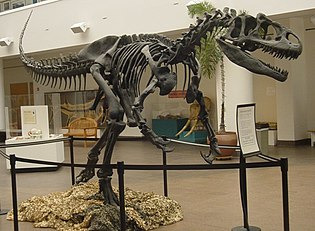
Due to the high concentration of predators in the area, the quarry has been interpreted as a predator trap. Unfortunately, so far, there isn't a ton of concrete evidence aside from the numbers to back that claim up.
A big thing to note with the Allosaurus: nearly all of them were sub-adults or juveniles.

Now, back to the story. I was in my third year? Maybe fourth, I don't know, it was so long ago now. Anyway, I was in college, taking a course called taphonomy (the study of what happens to organisms after they die, through burial until we recover them). We were looking at a map of the Cleveland-Lloyd Quarry and our professor, Dr. David Varricchio was having us go around the table in pairs or small groups to give explanations of why so many Allosaurus sub-adults in one area.
It started out pretty normal: youngsters might have stuck together and hunted in packs.
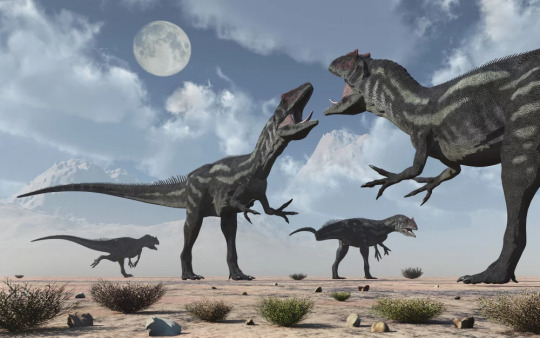
They were following a Stegosaurus herd trying to sus out the weakest link.

The environment was a flood pond, clay nested in a topographic low between levees and that clay was smectitic (filled with ash) making it sticky not unlike tar.

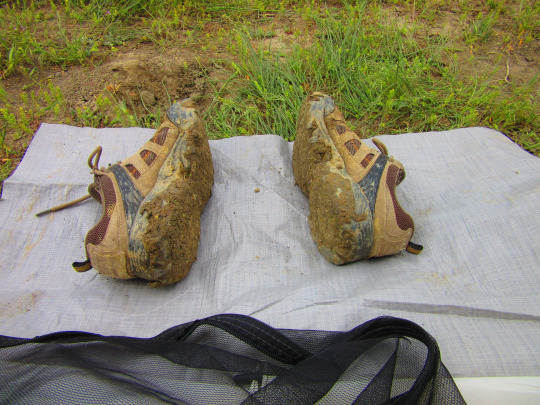
This type of clay will add 10lbs to the bottom of your shoes (it's why we don't start digging until summer. The spring makes this clay impossible to walk through. I mean, look at my poor boots). Imagine weighing as much as an Allosaurus and stepping into swelling clays. No bueno.
Well, eventually, we had gone around maybe two or three times and we were running out of typical reasons so my best friend and I, we came up with something...inventive.
Once upon a time, there was an Allosaurus civil war...

No, this is really good, I promise. You see, you always send the younger generation out to fight your wars right? That's why they're all sub-adults. The herbivores were their food stashes. The reason they also don't seem to have a lot of injuries? They were using their laser vision to kill each other which leaves no marks on the bones!

Thank you Animedino1 for having art haha.
Anyway, there was this pregnant pause after we had finished our explanation in which our classmates weren't sure how to respond and Dave looked like an error message was playing in front of his eyes. He replied saying "Well, I can't falsify it so I guess it could be true." So there you have it. A very well-known paleontologist said it could be possible so until further notice, I will believe in Allosaurus civil wars.

#paleontology#dinosaur#fossils#geology#funny shit#shitpost#late jurassic#allosaurus#jurassic national monument#cleveland-lloyd quarry#predator trap
5 notes
·
View notes
Note
cepheus, algol, meteor
cepheus: do you vibe more with the term idiot, asshole or dumbass?
I have big dumbass energy. Like, embarrassingly so. One time I tried to kick a can off a concrete wall and kicked the wall so hard I sprained my ankle. I once spent over one hour stuck in barbed wire. I have been fully beaten up by a giraffe. I have rolled 30 feet down the side of a canyon because I saw a bird and wasn’t paying attention to where I was walking. I did a bunch of jello shots like three weeks ago and told a fox it was beautiful. I’m a dumbass black hole.
algol: favourite planet? favourite space object?
I really liked that comet that visited in the middle of plague summer. It felt like a weird portent of things to come, and I sang the last song from Natasha, Pierre, and the Great Comet of 1812 at it a few times.
Honestly I’m not super knowledgeable about space. I’m sure there’s cooler stuff out there.
meteor: have you ever eaten dirt? if yes: on a scale from 0 to 10 would you do it again?
I studied geology, so yes, frequently. On a scale from best to worst dirt:
10: I went to a Michelin star (?) restaurant once. It was in (I think) a disused church, with the only rotting wood beams exposed in an otherwise modern ceiling, old brick walls sticking out between new modern ones. It was neat. I ordered a dish that was called something pretentious like “Air of the Forest” that was mix of foraged mushrooms, smoke, spring water, and a bunch of other stuff. Sprouts maybe made an appearance. They basically served me reverse engineered dirt. It tasted interesting (dirty) but I was mostly impressed by the gall of making rich idiots eat dirt.
0: I went to the Cleveland Lloyd Dinosaur Quarry in Utah, and we were looking for allosaurus bones (not scientifically, just as like a lark). I found a chip, and did the lick test, but it was super dusty, I started to sneeze as I reached my tongue out, and sucked a piece or a dinosaur deep into my body.
space asks cuz space is neat
7 notes
·
View notes
Text
“Is that a glider? Seriously?!” Peacekeeper, the adventure for Native American Nations, Vol. 1, for Shadowrun (1st Edition). Part 4.
Catch up on things here:
Part 1: Road Trip!
Part 2: Benny Hill
Part 3: Vegas, Chummer!
Let’s sum up what the runners know about their quarry, Jesse John:

Not to be confused with the Cleveland-Lloyd Quarry, home to the densest concentration of Jurassic dinosaur fossils ever known, also located in Utah.
They think he’s toxic

Just like this.
He has hired a decker named Ram to do… something? To a PCC system? Via a conveniently left behind datachip
He is now in someplace called “Pueblo-Under”, known via a conveniently left behind note
There’s another hired rando named “Aurora” that is working with him
There’s this broken tonal generator thing, which they really only know the significance of if they had gotten their hoops whooped by the Renraku team and they interrogated them for information on it, or they got ALL OF THE SIXES on their legwork rolls and have a vague idea about what it can do
What they don’t know about Jesse John:
What the drek all of this has to do with a business deal that the team has been hired to protect by tracking own and possibly murdering Jesse.
So, situation normal, for Shadowrun.
The plot catapult is set for Pueblo, so they go to Pueblo.
By this point, the ambushes have become blasé, and so you really must spice them up with something new. In this case: a go-ganger on a GODDAMN GLIDER.

What makes this perfect is the author’s last name.
And it’s a different go-gang than the one that hit them on the way into Vegas.

By this point you, the reader, and them, the PCs, know that no matter what they do, clues will drop into their lap at just the right point to head them in the right direction, so I’ll quickly gloss over the details of how this happens:
Provo-Under is the Pueblo Ork/Troll Underground
Jesse set up a troll ganger (Yes! Yet another gang!) to take the fall for an assassination
The infamous Aurora either does or doesn’t assassinate some other lady for reasons and she is flying back to Seattle
Meaning: the team could have saved themselves a lot of health levels and ammo if they had just sat on their hoops for a few days and let Jesse come back to them.
Alas.
6 notes
·
View notes
Text
The Continuously Evolving Picture of the World's Largest Raptor
https://sciencespies.com/nature/the-continuously-evolving-picture-of-the-worlds-largest-raptor/
The Continuously Evolving Picture of the World's Largest Raptor
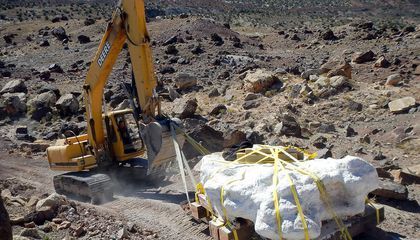
When Jurassic Park stomped into theaters during the summer of 1993, audiences suddenly became familiar with predators of the past like Dilophosaurus and Velociraptor. Right around that time, real-life paleontologists were figuring out an even bigger velociraptor relative, a dinosaur that has become a rock star in its own right.
Back in 1991, Utah State paleontologist Jim Kirkland and his crew were excavating a bonebed outside Moab, Utah, brimming with dinosaur fossils dating back 125 million years. While excavating an armored dinosaur that would eventually be named Gastonia (in honor of fossil reconstruction expert Robert Gaston), Kirkland found something more: the front of a jaw from a theropod, the class of dinosaurs containing such meat-eaters as T. rex. “Later that same field season, we found a sickle claw,” Kirkland recalls. The shape was unmistakable: The recurved claw was a dead ringer for the characteristic foot claw of dinosaurs like Deinonychus and Velociraptor, only this one was much larger. “It was twice as big as the same claw on Deinonychus,” Kirkland says.
Kirkland and his collaborators tossed around different names. “Dinoraptor” was a contender. At one point, there was a suggestion that the species name should be “spielbergi” to court the Jurassic Park director for some funding support. But the paleontologists ultimately went in a different direction.
That claw would become the single fossil that characterized a new animal: Utahraptor ostrommaysi. Its journey from rare find to state dinosaur of Utah to inspiration for the NBA’s Toronto Raptors illustrates the difficult, treacherous way in which scientists try to unravel the colossal carnivores that once roamed the planet.


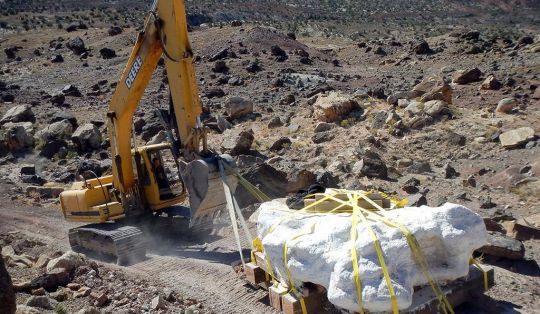

Utahraptor block being carried away for study in 2014.
(Jim Kirkland)
Many carnivorous dinosaurs live in scientific limbo for years. That’s because of the scarcity of fossils—simply put, large, predatory dinosaurs are rare, which makes sense from what we know about modern ecosystems. Plants will always outnumber herbivores, and herbivores will be more numerous than animals that eat them.
As luck would have it, though, a different team of paleontologists had stumbled upon Utahraptor decades before. In 1975, Brigham Young University paleontologist Jim Jensen collected a batch of theropod bones of about the same age from a nearby site called Dalton Wells. But few were fully prepared for study or described. They weren’t recognized as Utahraptor bones until years later when Kirkland recognized the similarities and the fossils were more fully-prepared.
Those bones made all the difference. Kirkland’s team had turned up a scant few bones from the jaw, foot, and leg at the new site. Based on the relationship of Utahraptor to other dinosaurs, the early representations of the dinosaur (including the journal description and an animatronic created for the Dinosaur Museum in Fruita, Colorado) depicted what was essentially a plus-sized Deinonychus. However, the Dalton Wells collection turned out to contain dozens of Utahraptor bones, enough to put pieces of multiple skeletons together to create a better version of the dino.
“Utahraptor is the largest dromaeosaur in the family,” says University of La Rioja paleontologist Angelica Torices. It is estimated to have stretched 23 feet long, weighed more than 600 pounds, and carried some deadly traits. “The claws on the hand seem to have been more specialized for cutting than other dromaeosaurs,” Torices says, and the teeth at the front of the lower jaw appear to angle forward farther than in other raptors.
Even so, Utahraptor probably used the same techniques that allowed most carnivorous dinosaurs to be efficient eaters. By studying various dinosaur teeth, Torices and colleagues found that carnivorous dinosaurs used a “grip and rip” feeding style. The dinosaurs would bite and pull backward, letting the serrations of their teeth do the work. Utahraptor probably chomped the same way.

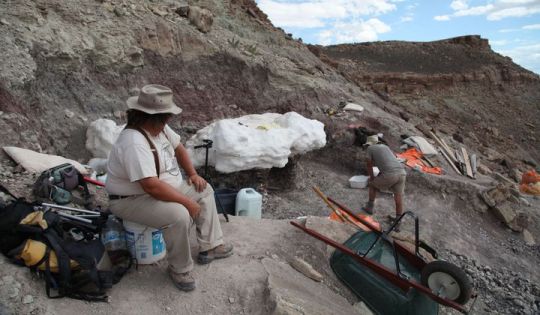
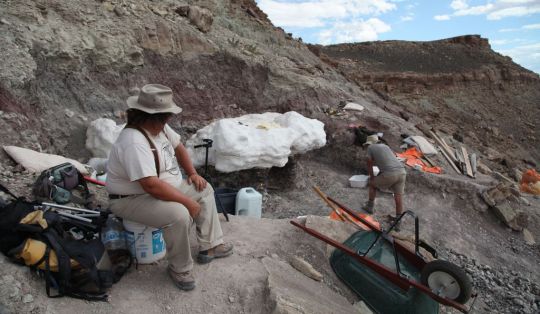

Block containing utahraptor fossils
(Jim Kirkland)
In the new century, new finds changed our image of Utahraptor again.
In 2001 a graduate student roaming around Moab spotted what initially looked like a human arm bone in an area of Early Cretaceous rock layers. The remains turned out to be more Utahraptor, and not an isolated bone or skeleton this time. When Kirkland and his team dug in, they unearthed dozens of Utahraptor bones from multiple individuals, from yearlings to full-grown adults, encased in a nine-ton block of Cretaceous quicksand. It took years of work to excavate and transport the block, but this collection contained the potential to provide a clearer view of Utahraptor than any of the earlier bonebed finds.
Excavations of the block are still underway, but we know it contains hundreds of bones, including skulls from three yearlings, five juveniles and one adult. Paleontological work is slow and exacting, but especially so in this case because the bones are tiny. The premaxilla (the front of the upper jaw) of a baby Utahraptor is about the size of a penny, for example.
The big bones, too, bring surprises. Adult Utahraptors were not 20-foot-long versions of Velociraptor, but much bulkier animals. “The new limb bones are 50 percent more massive than the same-sized Allosaurus bone,” Kirkland says, indicating that Utahraptor was more burly than slender. The skulls, too, look more like what you’d expect of a small tyrannosaur than a swift snapper.
Also, Utahraptor would have been fluffy. Recent discoveries connected to related dinosaurs including Velociraptor suggest Utahraptor would have been covered in feathers—a more elegant animal than the scaly renditions of dinosaurs common in the 1990s.
The Moab site might illuminate details of Utahraptor behavior as well. The nine-ton sandstone block containing the fossils appears to be a quicksand trap. The dinosaurs became stuck and were buried by the sloshy sediment that killed them. It’s unclear whether the animals were trapped at the same time or over a longer span, but the examination of how the bones are arrayed and the age of each Utahraptor might dovetail with evidence from tracks that some raptors were social and lived in groups.

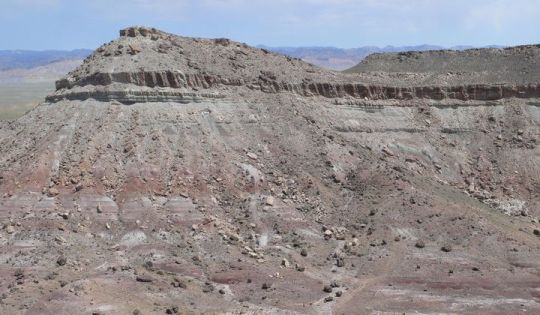


Utahraptor Ridge, Utah.
(Jim Kirkland)
All of these threads have made Utahraptor a Cretaceous celebrity. During the 1990s, the Toronto Raptors got their logo inspiration from Utahraptor and the dinosaur was the subject of the “paleofantasy” Raptor Red. Utahraptor has become such a dinosaur fan favorite that 10-year-old Kenyon Roberts was able to bend the ear of Utah state senator Curt Bramble and convince him that Utahraptor should become the state’s dinosaur.
Just one problem: Utah already had a state dinosaur. The Jurassic predator Allosaurus had been selected because of the huge amount of Allosaurus bones from more than 48 individual animals that had been uncovered in eastern Utah’s Cleveland-Lloyd Dinosaur Quarry.
It was a 21st-century dinosaur showdown. Some Utahans felt the state didn’t need a new state dinosaur and didn’t want to push aside part of the state’s fossil history. So a compromise was struck: In a 26-0 vote conducted in 2018, Utahraptor was made Utah’s state dinosaur and Allosaurus was shifted to be the state fossil. The Mesozoic meat-eaters were able to coexist as state symbols.
Utahraptor may be poised to jump to even greater fame. A proposal to preserve the Dalton Wells quarry as Utahraptor State Park recently ran through the Utah legislature. Unfortunately, the bill became a bit stuck—not unlike the dinosaurs themselves from the quicksand block. but when asked if there is still hope for the proposal, Kirkland says “Absolutely!”
Utah is rife with dinosaurs, but this super-sized raptor seems to be a cut above.
#Nature
1 note
·
View note
Video
tumblr
lulu2240
Here is my favorite fossil - the Jurassic dinosaur Allosaurus!Allosaurus is a very graceful, sleek looking predator with just a hint of vanity seen in the small lacrimal or brow ‘horn’ above its eye. Our Allosaurus comes all the way from Utah, from the famous Cleveland-Lloyd Quarry where a number of Allosaurus individuals have been found. Isn’t it a beautiful animal?
#Dinosaur#fossil#jurassic#bones#allosaurus#geology#fossilfriday#utah#cleveland#quarry#rock#limestone#video#instagram#the earth story
292 notes
·
View notes
Photo
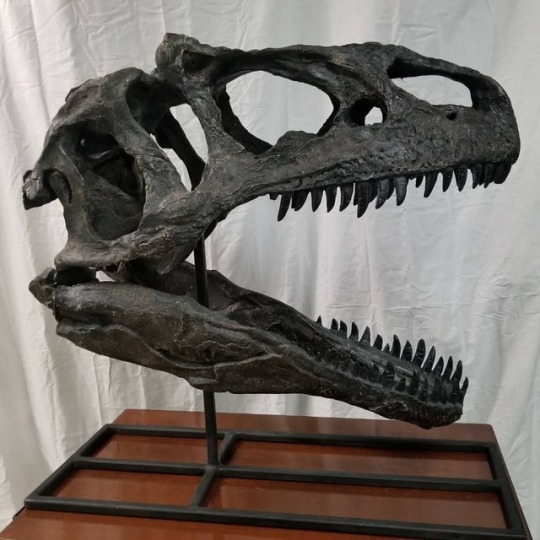
This is a museum cast of an Allosaurus skull - an apex predator, theropod, dinosaur! These ferocious reptiles roamed the Earth in the late Jurassic period (155-150 million years ago). Armed with dozens of sharp, serrated, teeth, and averaging 8.5m (28ft) in total length, this dinosaur was a powerful killing machine. This full-size skull is cast from a real allosaurus skeleton that was excavated in the Dinosaur National Monument of Utah & Colorado. The real skull is on display at this national park and this cast is used on the articulated skeleton! You can also find this exact casting on display at the Cleveland Lloyd Dinosaur Quarry, the Natural History Museum of Utah and several other facilities across the continent. This is a rare opportunity to privately own a museum-grade specimen! This dinosaur skull measures just shy of 3ft (90cm) long, and (including stand) ~32.5" (82.5cm) tall and 1ft (30cm) wide. Worldwide shipping is available. We are asking $6450CAD (~4890USD), buy it now on www.SkullStore.ca or in-store Thursday-Sunday (12-6pm) at 1193 Weston Rd, Toronto. (at Skull Store) https://www.instagram.com/natural_selections/p/BuT_tvjgDPS/?utm_source=ig_tumblr_share&igshid=ue9667mdijn9
20 notes
·
View notes